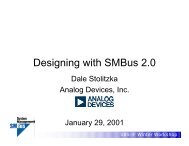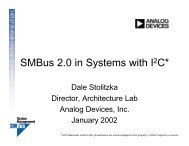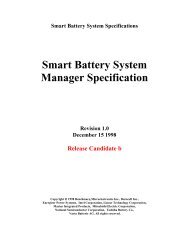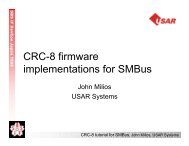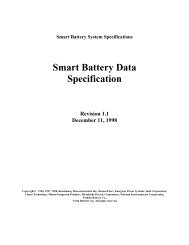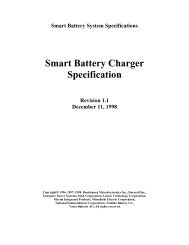Smart Battery Selector Specification Revision 1.1 - SBS-IF Smart ...
Smart Battery Selector Specification Revision 1.1 - SBS-IF Smart ...
Smart Battery Selector Specification Revision 1.1 - SBS-IF Smart ...
You also want an ePaper? Increase the reach of your titles
YUMPU automatically turns print PDFs into web optimized ePapers that Google loves.
<strong>Smart</strong> <strong>Battery</strong> <strong>Selector</strong> <strong>Specification</strong>3. Definitions• APM: Advanced Power Management. A BIOS interface defined to enable system-wide powermanagement control via software.• <strong>Battery</strong>: One or more cells that are designed to provide electrical power.• Cell: The cell is the smallest unit in a battery. Most batteries consist of several cells connected in aseries and/or parallel combination.• I²C-bus: A two-wire bus developed by Philips, used to transport data between low-speed devices.• <strong>Smart</strong> <strong>Battery</strong>: A battery equipped with specialized hardware that provides present state andcalculated and predicted information to its SMBus Host under software control.• <strong>Smart</strong> <strong>Battery</strong> Charger: A battery charger that periodically communicates with a <strong>Smart</strong> <strong>Battery</strong> andalters its charging characteristics in response to information provided by the <strong>Smart</strong> <strong>Battery</strong>.• <strong>Smart</strong> <strong>Battery</strong> <strong>Selector</strong>: A device that arbitrates between two or more <strong>Smart</strong> Batteries. It controls thepower and SMBus paths between the SMBus Host, a <strong>Smart</strong> <strong>Battery</strong> Charger and the <strong>Smart</strong> Batteries.• <strong>Smart</strong> Device: An electronic device or module that communicates over the SMBus with the SMBusHost and/or other <strong>Smart</strong> Devices. For example the back-light controller in a notebook computer can beimplemented as a <strong>Smart</strong> Device.• SMBus: The System Management Bus is a specific implementation of an I²C-bus that describes dataprotocols, device addresses and additional electrical requirements that is designed to physicallytransport commands and information between the <strong>Smart</strong> <strong>Battery</strong>, SMBus Host, <strong>Smart</strong> <strong>Battery</strong> Chargerand other <strong>Smart</strong> Devices.• SMBus Host: A piece of portable electronic equipment with some measure of intelligence powered bya <strong>Smart</strong> <strong>Battery</strong>. It is able to communicate with the <strong>Smart</strong> <strong>Battery</strong> and use information provided by thebattery.• Packet Error Check (PEC): An additional byte in the SMBus protocols used to check for errors in anSMBus transmission. Refer to the System Management Bus <strong>Specification</strong> <strong>Revision</strong> <strong>1.1</strong>. A <strong>Smart</strong><strong>Battery</strong> <strong>Selector</strong> indicates its ability to support PEC with the SELECTOR_REVISION value in<strong>Selector</strong>Info() function.4. <strong>Smart</strong> <strong>Battery</strong> <strong>Selector</strong>Why is a <strong>Smart</strong> <strong>Battery</strong> <strong>Selector</strong> necessary? It would seem that the obvious method for adding an additional<strong>Smart</strong> <strong>Battery</strong> to any system would be simply to allocate an additional SMBus address for the secondbattery. Unfortunately, this is not practical; the SMBus address is merely one part of the system, definingthe data path for smart battery data transactions between the system host, the charger and the battery itself.Other significant connections are required.In most multiple-battery systems today, some device or mechanism must be present to arbitrate between thebatteries. Additionally, this device must be able to dynamically re-configure the system’s power withsufficient speed to prevent any negative side-effects caused by removal of the system’s primary battery. Auser may neither know nor care which battery is powering the system, but the user does expect that thesystem will keep on working. For example, in a system where a slot is shared between a battery and afloppy disk drive, the user may simply remove the battery to install the floppy drive. If this example systemwas powered by the battery in the shared slot, the <strong>Smart</strong> <strong>Battery</strong> <strong>Selector</strong> must be able to switch to the otherbattery quickly enough that the system’s power integrity is not compromised.The system’s power management must also be informed that there has been a change in the <strong>Selector</strong>State().The <strong>Smart</strong> <strong>Battery</strong> <strong>Selector</strong> must have the ability to notify the system (preferably via an SMBALERTsignal) that a change has occurred so the system can get updated information as required.The battery selector described in this specification can provide this level of functionality.<strong>SBS</strong> Implementers Forum Page 2<strong>Revision</strong> <strong>1.1</strong>




